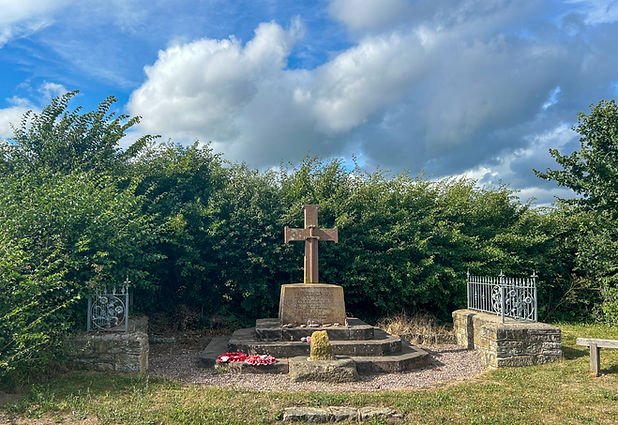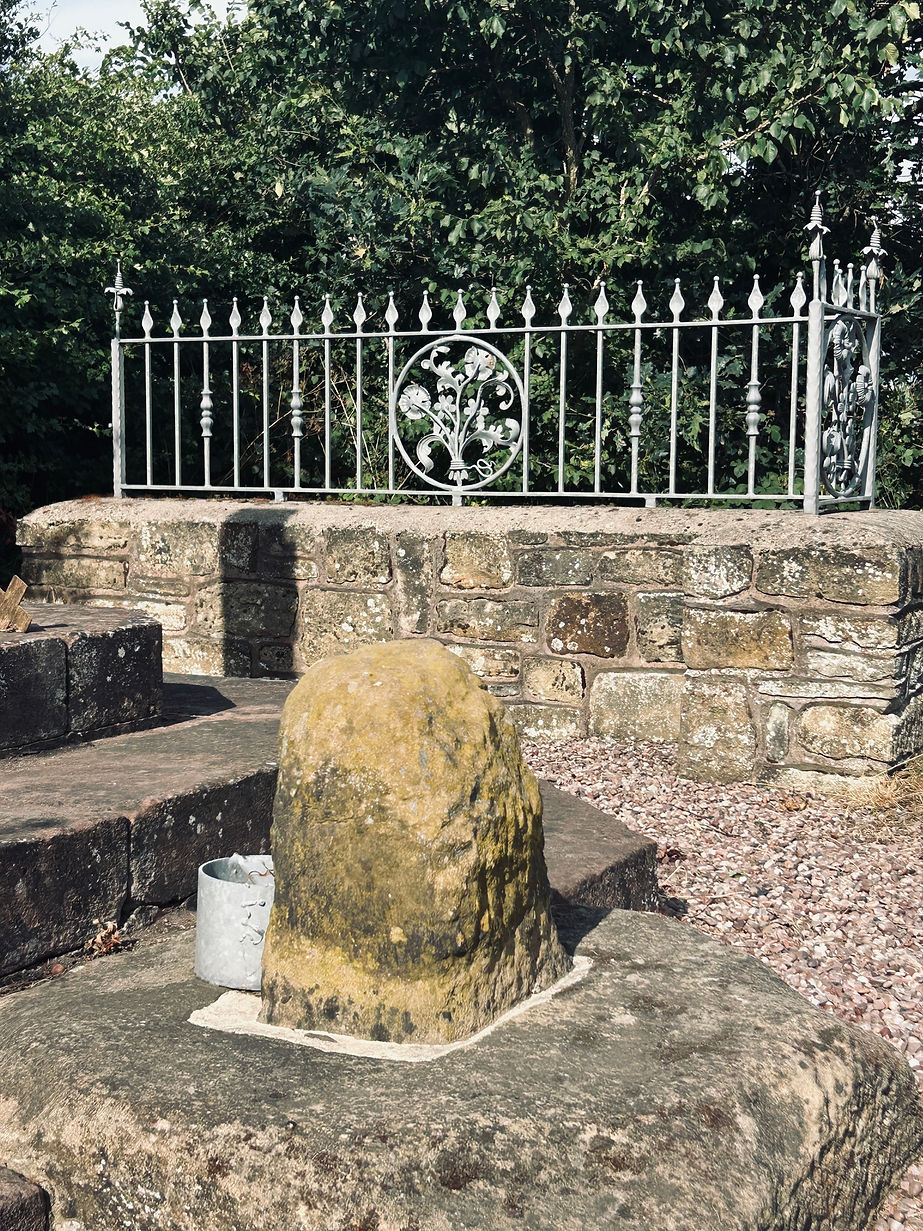
There was a time when medieval crosses were so very ubiquitous in the landscape that they barely warranted a mention in the works of those we may suppose to have written about them. This lack of reference, this sparsity of notice has gone some way to give vague weight to a belief in their rarity - perhaps even in their medieval heyday. Their survival, often as sundials or broken stumps often goes unnoticed as a result - made invisible by our wayward weening. We look upon the time worn but largely intact wonders of Derwen, Trelawnyd, Tremeirchion and Hanmer and fail to notice the shattered remains elsewhere, the stubborn lumps in churchyards and beside ancient trackways - and modern war memorials.

Such is the case with the Croes Howel cross, the stump of which stands before the war memorial on the corner of Higher Lane between Llay and Burton. This stump, this nub of a thing is less than a half metre tall bit of worn sandstone, set in a heavy set, almost square base stone - but determinedly unignorable, nonetheless. And perhaps more so for the modern context in which this ancient stone now finds itself within.
The Croes Howel cross does appear in the written record - rarely, and fleetingly, but it is there, and perhaps more so than others, more than the impressive massives, in fact. It is first mentioned in the Minister Accounts of Burton Manor dated to 1479-80, where it is said to be described as ‘conspicuous’. A curious word that - conspicuous. There can be no doubt that those surviving tall crosses with their magnificent crossheads and tabernacles are unlikely to go unnoticed - so little doubt in fact, that one wonders why the word would be necessary in describing medieval crosses. But of course, not all medieval crosses were churchyard crosses and not all medieval crosses would have been as large and impressively decorated as churchyard wonders, or even town or market crosses. And the word ‘conspicuous’ is, in fact, a rather wonderful way of perfectly describing a roadside or wayside cross, when you think about it. That’s what we have here, likely as not, a cross marking the old routeway, and being conspicuous would make good practical sense.(1)

The cross is mentioned twice in the 17th century. The English cartographer and author of devotional writings, John Norden (1547-1623), makes mention of a Maes Croes Howel (2) somewhat obliquely, in his Survey of the Lordship of Bromfield and Yale at the beginning of the century, while Edward Lhuyd writes of a Kroes Howel in his survey of Gresford, the township within which Burton was sited at the time at the end of the century. Neither author mentions anything else regarding the cross, and one can only wonder, given the ravages of time and the religious upheavals of the 16th and 17th centuries as to the condition of the cross. But then, it is unlikely that wayside crosses were subjected to the same teeth-gnashing, chest beating religious ire that churchyard crosses inspired.
The original siting of the cross is not known precisely but was likely close to its current position. We do know that at the beginning of the 20th century it was standing to the north of the road by the wood on Croes Howel Hill. It was moved a short distance along the fringes of the wood to a spot adjacent the lawn of Croes Howel House - possibly due to a widening of the road. Croes Howel House was owned at this time by John and Mary Sykes who had moved to Burton from Leeds by 1901. John died in 1908, but Mary remained at Croes Howel until her own death in 1951. During the First World War, the House was requisitioned for use as an Auxiliary Military Hospital with Mary as its commandant, for which she received an MBE in January 1918. The experience cannot have but moved her profoundly, and at some time after the War’s end, Mary had a memorial raised on the site of the ancient cross that stood by her house - her house that had witnessed so deeply the unmitigated tragedy and misery of the consequences of war.
THIS CROSS IS ERECTED AND THE/ RUINED CROSS REVERENTLY REPLACED/ BY MARY L SYKES OF CROES-HOWELL/ IN EVER-LIVING MEMORY OF OUR MEN/ WHO DIED FIGHTING FOR THE RIGHT/ 1914-1918/ "WHO SO TAKES THIS WORLDS LIFE UPON HIM/ AND HIS OWN LAYS DOWN,/ HE, DYING SO, LIVES."/ IN UNION WITH THY DIVINE SACRIFICE/ ACCEPT OURS O LORD.

The realisation that medieval crosses continue to have meaning, hundreds of years after their first raising for whatever the original reason, is nowhere better illustrated than here, at Croes Howel. When Mary Sykes came to raise her memorial to those that had passed in The Great War, she saw no better place than here, by the ancient cross.
Croes Howel, and the war memorial which it now fronted, were moved once more, in 1975 to its current position set back a little from the road, when the B5102 was further widened. It stands there still.
Footnotes
1. Having said that, there is the noggin pecking thought of it being once a roadside preaching cross. It would explain it being noticed, if only in passing, by Norden & Co.
2. Norden was actually referring to a field (maes) that had taken the name of the cross.
Further Reading
E. Lhuyd, The Parochialia, Archaeologia Cambrensis Supplement, April 1909
A. N. Palmer, History of the Old Parish of Gresford in the counties of Denbigh and Flint, Archaeologia Cambrensis, Vol. IV, (1904)
RCAHM, An Inventory of the Ancient Monuments in Wales and Monmouthshire, Denbigh, London, (1914)
R. J. Silvester & R. Hankinson, Medieval Crosses and Crossheads, CPAT Report No. 1036, (March 2010)
Original Documents, Archaeologia Cambrensis, Vol. 1, (1877)

